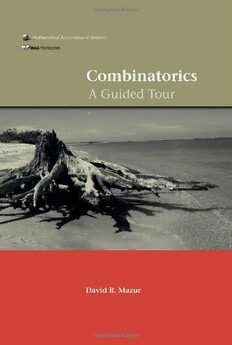Table Of Contenti i
“master” — 2010/9/20 — 12:30 — page i — #1
i i
Combinatorics
A Guided Tour
i i
i i
i i
“master” — 2012/7/26 — 15:22 — page ii — #2
i i
(cid:13)c 2010by
TheMathematicalAssociationofAmerica(Incorporated)
LibraryofCongressCatalogCardNumber2009937059
ElectronicISBN:978-1-61444-607-1
PrintISBN:978-0-88385-762-5
PrintedintheUnitedStatesofAmerica
CurrentPrinting(lastdigit):
10987654321
i i
i i
i i
“master” — 2010/9/20 — 12:30 — page iii — #3
i i
Combinatorics
A Guided Tour
David R. Mazur
Western New England College
®
Publishedanddistributedby
TheMathematicalAssociationofAmerica
i i
i i
i i
“master” — 2010/9/20 — 12:30 — page iv — #4
i i
CommitteeonBooks
PaulM.Zorn,Chair
MAATextbooksEditorialBoard
ZavenA.Karian,Editor
GeorgeExner
ThomasGarrity
CharlesR.Hadlock
WilliamHiggins
DouglasB.Meade
StanleyE.Seltzer
ShahriarShahriari
KayB.Somers
i i
i i
i i
“master” — 2010/9/20 — 12:30 — page v — #5
i i
MAATEXTBOOKS
CalculusDeconstructed:ASecondCourseinFirst-YearCalculus,ZbigniewH.Nitecki
Combinatorics:AGuidedTour,DavidR.Mazur
Combinatorics:AProblemOrientedApproach,DanielA.Marcus
ComplexNumbersandGeometry,Liang-shinHahn
ACourseinMathematicalModeling,DouglasMooneyandRandallSwift
CryptologicalMathematics,RobertEdwardLewand
DifferentialGeometryanditsApplications,JohnOprea
ElementaryCryptanalysis,AbrahamSinkov
ElementaryMathematicalModels,DanKalman
EssentialsofMathematics,MargieHale
FieldTheoryanditsClassicalProblems,CharlesHadlock
FourierSeries,RajendraBhatia
GameTheoryandStrategy,PhilipD.Straffin
GeometryRevisited,H.S.M.CoxeterandS.L.Greitzer
GraphTheory:AProblemOrientedApproach,DanielMarcus
KnotTheory,CharlesLivingston
LieGroups:AProblem-OrientedIntroductionviaMatrixGroups,HarrietPollatsek
MathematicalConnections:ACompanionforTeachersandOthers,AlCuoco
MathematicalInterestTheory,SecondEdition,LeslieJaneFedererVaalerandJamesW.Daniel
MathematicalModelingintheEnvironment,CharlesHadlock
MathematicsforBusinessDecisionsPart1:ProbabilityandSimulation(electronictextbook),Richard
B.ThompsonandChristopherG.Lamoureux
MathematicsforBusinessDecisionsPart2:CalculusandOptimization(electronictextbook),Richard
B.ThompsonandChristopherG.Lamoureux
TheMathematicsofGamesandGambling,EdwardPackel
MathThroughtheAges,WilliamBerlinghoffandFernandoGouvea
NoncommutativeRings,I.N.Herstein
Non-EuclideanGeometry,H.S.M.Coxeter
NumberTheoryThroughInquiry,DavidC.Marshall,EdwardOdell,andMichaelStarbird
APrimerofRealFunctions,RalphP.Boas
ARadicalApproachtoRealAnalysis,2ndedition,DavidM.Bressoud
RealInfiniteSeries,DanielD.BonarandMichaelKhoury,Jr.
TopologyNow!,RobertMesserandPhilipStraffin
UnderstandingourQuantitativeWorld,JanetAndersenandToddSwanson
MAAServiceCenter
P.O.Box91112
Washington,DC20090-1112
1-800-331-1MAA FAX:1-301-206-9789
i i
i i
i i
“master” — 2010/9/20 — 12:30 — page vi — #6
i i
i i
i i
i i
“master” — 2010/9/20 — 12:30 — page vii — #7
i i
Preface
Thisbookprovidesa journeythroughintroductorycombinatoricsthatthe reader can un-
dertakeduringonesemester,twoquarters,orinaindependentstudyorself-studysetting.It
isnotintendedtobeencyclopedic.Rather,itsurveysagoodcross-sectionofcombinatorics
as ithas developedwithinthelastcenturywithan eye towardsitscharacteristic brandof
thinking,itsinterconnectionswithothermathematicalfields,andsomeofitsapplications.
Combinatoricscanrightlybecalledthemathematicsofcounting.Morespecifically,it
isthemathematicsoftheenumeration,existence,construction,andoptimizationquestions
concerningfinitesets.Herearesomebriefillustrations.
Enumeration: How many? How many different 9 9 Sudoku boards are there?
(cid:15) (cid:2)
Thisnumberhasbeencomputedexactlyanditisastronomical—about6.6sextillion.
Determining this number by simply listingevery possible board is not a viable ap-
proach.Combinatoricsinvolvesmathematicaltechniquesfordeterminingtheanswer
toacountingquestionwithoutlistingtheobjectsbeingcounted.
Existence:Isitpossible?Takeany25peoplelivingontheearth.Amongthemembers
(cid:15)
ofthisgroupwillyoualwaysbeabletofindfourpeoplewhoallknoweachotheror
elsefivepeoplewhoalldon’tknoweachother?Yes:thisisguaranteednomatterwhat
group of 25 you choose. Despite its innocent-soundingnature, thisquestion wasn’t
answereduntil1993andrequiredcarefulcombinatorialanalysisaswellasthousands
ofhoursofcomputertime.
Construction: Can it be built?The Mariner 9 spacecraft orbitedMars in 1971-72
(cid:15)
andsentbackphotographsthatgaveacompletepictureoftheplanet’ssurface. Your
CDplayercanplayadiscflawlesslydespiteoccasionalscratchesonthedisc’ssurface.
Both of these applications involve error-correcting codes that transmit information
with100%accuracy despiteoccasionalerrorsintransmission.Constructionmethods
formanyerror-correctingcodesusecombinatorics.
Optimization: What is the best way? Your car’s GPS navigation system quickly
(cid:15)
finds the fastest route from point A to point B. It essentially solves instances of a
combinatorial optimization problem called the shortest path problem, which is but
oneofabroadclassofnetworkoptimizationproblemsthathavewidespreadmodern
application.
Inthisbookweconsiderenumeration,existence,andconstructionquestions.
Theexamplesaboverightlysuggestthatcombinatoricshasmanymodernapplications.
Counting techniques are indispensable in applied probability when the sample space is
finite and outcomes are equally likely. Combinatorial design theory grew out of a need
vii
i i
i i
i i
“master” — 2010/9/20 — 12:30 — page viii — #8
i i
viii Preface
that statisticianshad inconstructingvalidexperimental designs. Computerscience is re-
pletewithapplicationsascombinatorialthinkinginformstheefficiencyofalgorithmsand
datastructuresaswellasthecorrectnessofrecursiveprocedures.Linearprogrammingand
combinatorial optimizationare fields born from the large-scale logisticalplanningprob-
lemsofWorldWarIIandnowinclude,amongmanyothers,applicationstothedesignof
transportation and telecommunications networks. Operations research, management sci-
ence,andindustrialengineeringareotherfieldsinwhichcombinatorialanalysisisusedto
solveimportantandpracticalproblems.
Beyondspecific examples andproblems,though,thebroaderviewisthatcombinato-
rialthinkingisbeneficialandapplicabletomanyareasofmathematics,statistics,computer
science, andengineering.Twoofthelargestprofessionalsocieties inthefieldsofmathe-
maticsandcomputerscience—the MathematicalAssociationofAmerica (MAA)andthe
Association for Computing Machinery (ACM)—recommend that majors and minors in
mathematicsandcomputersciencetakecoursesinvolvingagoodamountofdiscretemath-
ematicsandcombinatorics.
Assuch, combinatoricsisnowproperlyintertwinedwithmodernmathematics. Inthe
recent past, combinatoricswas viewedas a usefulsetoftoolsand,at best, asurrogateto
otherfields.Nowthatcombinatoricshasgelledintoamorecoherentwhole,itisinteresting
toseehowfieldssuchascalculus,analysis,numbertheory,abstractandlinearalgebra,and
differentialequationscan be usedas toolstosolvepurelycombinatorialproblems.Some
ofthoseresultsaretruemathematicalhighlights.
What’s on the tour and what’s not
Asmentionedearlier,thisbookprovidesanintroductorysurveyofenumeration,existence,
andconstructionquestions.Theemphasisisonenumerationandthefirstfivechapterspro-
videthecorematerialoncountingtechniquesandnumberfamilies.Theremainingchapters
takeupgraphs,combinatorialdesigns,error-correctingcodes,andpartiallyorderedsets.
InChapter1webeginwiththeclassificationandanalysisofbasiccountingquestions.
Wealsolaythegroundworkfortherestofourjourneybyintroducingfiveessentialcombi-
natorialprinciples:theproductandsumprinciples,thebijectionprinciple,theequivalence
principle,andthepigeonholeprinciple.Thelatterisexistential,notenumerative,innature.
InChapter2weundertakethestudyofdistributionproblems.Mostcountingquestions
are equivalent to questions of counting the ways to distribute “objects” to “recipients.”
Throughthesedistributionproblemswemeetseveralmajorplayers:binomialcoefficients,
Stirlingnumbers, and integer partitionnumbers. We also introduce and emphasize com-
binatorialproofs as wellas the technique of recursion:breakingup a large problem into
smallersubproblemsofthesametype.
In Chapter 3 we introduce inclusion-exclusion, mathematical induction, generating
functions,andrecurrencerelations.Thesearealgebraictechniquesincontrasttothecombi-
natorialtechniquesofthepreviouschapters.Thecoverageofgeneratingfunctionsincludes
techniquesforsolvingrecurrencerelations.
In Chapter 4 we use the techniques of the previouschapters to give a more in-depth
studyofthebinomialandmultinomialcoefficients, Fibonaccinumbers, Stirlingnumbers
ofthefirstandsecondkinds,andintegerpartitionnumbers.Amongotherlinesofinvesti-
gation,wederivegeneratingfunctionsforthesefamiliesofnumbers,counttriangulations
i i
i i
i i
“master” — 2010/9/20 — 12:30 — page ix — #9
i i
Preface ix
of the regular n-gon, give combinatorialproofs ofFibonacci number identitiesusingthe
ideaoftiling,deriveabeautifulformulafortheBellnumbers,andexploreformulasandan
asymptoticestimatefortheintegerpartitionnumbers.
InChapter5wecovercountingproblemsinvolvingequivalenceandsymmetryconsid-
erations. The main results are the Cauchy-Frobenius-Burnsidetheorem and Po´lya’s enu-
merationtheorem. ThoughPo´lya’stheoremarosefromanapplicationtotheenumeration
ofchemicalcompounds,ithassinceprovedtobeapowerfulandversatiletoolinallsorts
ofotherapplications.We beginthischapter byintroducingthoseaspects ofgrouptheory
necessary to understand the theorems, and then give many illustrationsof how to apply
them.
InChapter6we givea shortsurveyofsome combinatorialproblemsingraphtheory.
These include the enumeration oflabeled trees and binary search trees, coloringand the
chromatic polynomial, and introductoryRamsey theory. Though Ramsey theory can be
introduced without the aid of graphs, the edge-coloring interpretation is convenient and
concrete.Thefirstsectionofthischaptercoversbasicgraphtheoryconceptsforthereader
whoisunfamiliarwithgraphs.
InChapter7wecovertwoofthemostcompellingapplicationsofcombinatorics:com-
binatorialdesignsanderror-correctingcodes.Asabonus,themathematicalquestionssur-
rounding these applications are just as compelling if not more so. In the three sections
on designs we cover existence and construction methods, symmetric designs, and triple
systems. In thetwosections onerror-correctingcodes, we constructthe familyofbinary
Hamming codes and derive theirerror-correctingproperties, studytheinterplaybetween
codes and designs, and discuss the truly astonishing results concerning the existence of
perfectcodes.
In Chapter 8 we conclude our journey by studyingrelations that are, in some sense,
lurkingbehindmuch ofcombinatorics:partiallyorderedsetsor“posets.” We studysome
classicalresults(Sperner’stheoremandDilworth’stheorem)andalsotheconceptofposet
dimension.InthefinaltwosectionsweintroducethetheoryofMo¨biusinversionanddoso
withatwo-foldpurpose:toprovideaunifyingframeworkforseveralcombinatorialideas
andtopreparethereaderforfurtherstudy.
There are several important topics not included on the tour. The coverage of graph
theoryinChapter6,thoughitcontainsanintroductorysection,isfocusedfairlynarrowly
onthe topicsmentionedearlier. A majorbranch ofcombinatorics, namely combinatorial
optimization,isleftoutentirely.Also,thecoverage ofdesignsandcodes isdrivenbythe
particularapplications.Assuch,wedonotcoverprojectiveplanes,combinatorialgeome-
tries,orLatinsquares.
Features of this book
Readingquestions.Whatmakesthisbookaguidedtouraretheapproximately350Ques-
tionsspreadthroughouttheeightchapters. These allowthereadertobeanactive partici-
pantinthediscussionandaremeanttoprovideamorehonestreflectionoftheprocessby
whichwealllearnmathematics.Readingamathbookwithoutpencilandpaperinhandis
likestayinginyourhotelandviewingtheinterestingsitesfrom yourwindow.You’llget
moreoutofthetourifyouleavethehotelandgoexploreonfoot.
i i
i i

